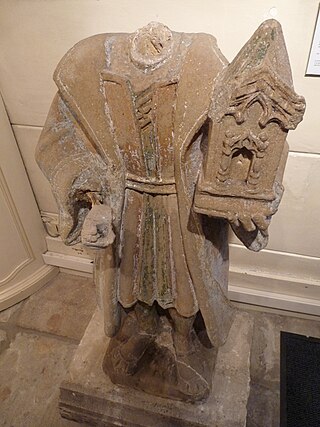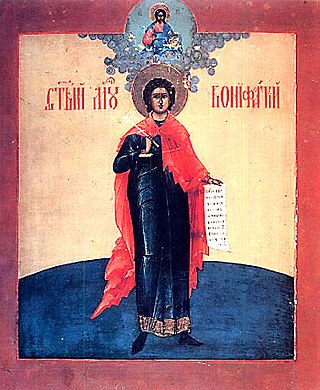Related Research Articles

Pope Stephen I was the Bishop of Rome from 12 May 254 to his death on 2 August 257. He was later canonized as a saint and some accounts say he was killed while celebrating Mass.
Pope Felix I was the bishop of Rome from 5 January 269 to his death on 30 December 274.

Pope Soter was the bishop of Rome from c. 167 to his death in c. 174. According to the Annuario Pontificio, the dates may have ranged from 162–168 to 170–177. He was born in Fondi, Campania, today in the Lazio region of Italy. Soter is known for declaring that marriage was valid only as a sacrament blessed by a priest and also for formally inaugurating Easter as an annual festival in Rome. His name, from Greek Σωτήριος from σωτήρ "saviour", would be his baptismal name, as his lifetime predates the tradition of adopting papal names.

Pope Lucius I was the bishop of Rome from 25 June 253 to his death on 5 March 254. He was banished soon after his consecration, but gained permission to return. He was mistakenly classified as a martyr in the persecution by Emperor Valerian, which did not begin until after Lucius' death.

Pope Anicetus was the bishop of Rome from c. 157 to his death in April 168. According to the Annuario Pontificio, the start of his papacy may have been 153. Anicetus actively opposed Gnosticism and Marcionism. He welcomed Polycarp of Smyrna to Rome to discuss the Easter controversy.

Pope Anacletus, also known as Cletus, was the bishop of Rome, following Peter, and Linus. Anacletus served between c. AD 79 and his death, c. AD 92. Cletus was a Roman who, during his tenure as pope, ordained a number of priests and is traditionally credited with setting up about twenty-five parishes in Rome. Although the precise dates of his pontificate are uncertain, he "...died a martyr, perhaps about 91". Cletus is mentioned in the Roman Canon of the mass; his feast day is April 26.

Pope Zephyrinus was the bishop of Rome from 199 to his death on 20 December 217. He was born in Rome, and succeeded Victor I. Upon his death on 20 December 217, he was succeeded by his principal advisor, Callixtus I. He is known for combating heresies and defending the divinity of Christ.

Pope Marcellinus was the bishop of Rome from 30 June 296 to his death in 304. A historical accusation was levelled at him by some sources to the effect that he might have renounced Christianity during Emperor Diocletian's persecution of Christians before repenting afterwards, which would explain why he is omitted from lists of martyrs. The accusation is rejected, among others, by Augustine of Hippo. He is today venerated as a saint in the Catholic Church and in the Serbian Orthodox Church.

Remesiana was an ancient Roman city and former bishopric, which remains an Eastern Orthodox and also a Latin Catholic titular see, located around and under the modern city of Bela Palanka in Serbia.
Cyriacus, sometimes Anglicized as Cyriac, according to Christian tradition, is a Christian martyr who was killed in the Diocletianic Persecution. He is one of twenty-seven saints, most of them martyrs, who bear this name, of whom only seven are honoured by a specific mention of their names in the Roman Martyrology.

Felix of Nola was a Christian presbyter at Nola near Naples in Italy. He sold off his possessions to give to the poor, but was arrested and tortured for his Christian faith during the persecution of Roman Emperor Decius. He was believed to have died a martyr's death during the persecution of Decius or Valerian but is now listed in the General Roman Calendar as a confessor of the faith, who survived his tortures.

Gorgonius or Gorgon was a Christian who was martyred in AD 304 alongside Peter Cubicularius and a certain Dorotheus at Nicomedia during the Diocletianic Persecution.

Nabor and Felix were Christian martyrs thought to have been killed during the Great Persecution under the Roman emperor Diocletian. A tomb in Milan is believed to contain their relics.

Liborius of Le Mans was the second Bishop of Le Mans. He is the patron saint of the cathedral and archdiocese of Paderborn in Germany. The year of his birth is unknown; he died in 397, reputedly on 23 July.

Saint Placidus (Placitus), along with Saints Eutychius (Euticius), Victorinus and their sister Flavia, Donatus, Firmatus the deacon, Faustus, and thirty others, have been venerated as Christian martyrs. They were said to be martyred either by pirates at Messina or under the Emperor Diocletian.
Abbo of Auxerre was a Benedictine abbot and bishop of Auxerre.

Saint Romaric was a Frankish nobleman who lived in Austrasia from the late 6th century until the middle of the 7th century. He and Amatus of Grenoble founded Remiremont Abbey.

Agapitus is venerated as a martyr saint, who died on August 18, perhaps in 274, a date that the latest editions of the Roman Martyrology say is uncertain.

Saint Boniface of Tarsus was, according to legend, executed for being a Christian in the year 307 at Tarsus, where he had gone from Rome in order to bring back to his mistress Aglaida relics of the martyrs.

Illyrian education is a term in the field of the history of education and pedagogical thought that denotes the totality of forms, organizations and educational institutions in the Illyria and among Illyrians. In the early periods, the education in Illyria and among the Illyrians was under the influence of Greek education, while later it was under the influence of Roman culture. Based on the latest scientific research and discoveries in various aspects of Illyrology: historical, archeological, epigraphic, linguistic, paleographic, etc., it has become possible to better summarize the Illyrian educational system. Illyrian education stretches over a period of time between the 8th century BCE, when the Illyrian culture began to flourish, and the 7th century CE, when the Illyrians are last mentioned in historical sources. In general, it can be said that education among the Illyrians was developed starting from a level of family and informal education towards an organized, institutional, and formal educational system.
References
- ↑ "Letter of Pope John Paul II for the third centenary of the union of the Greek-Catholic Church of Romania with the Church of Rome".
- ↑ "1994 | Gottfried Schramm: A New Approach to Albanian History". www.albanianhistory.net. Retrieved February 29, 2020.
- ↑ "quod barbaros oves factos Evangelium edocuisset atque in pacis aulam duxisset et quondam inperiti ac latrones Christum corde romano resonare didicisset" (Martyrologium Romanum Libreria Editrice Vaticana 2001. ISBN 88-209-7210-7, p. 330).
- ↑ Philippe Blasen, “Nicetas of Remesiana – A Missionary Bishop in Dacia?” in Studia Universitatis Babeș-Bolyai Theologia catholica, 1-2, 2012, 39-49
- ↑ Kirsch, Johann Peter. "Nicetas." The Catholic Encyclopedia Vol. 11. New York: Robert Appleton Company, 1911. 27 February 2016
- ↑ Martyrologium Romanum. Libreria Editrice Vaticana 2001. ISBN 88-209-7210-7; Gross, Ernie. This Day In Religion. New York:Neal-Schuman Publications, 1990. ISBN 1-55570-045-4.